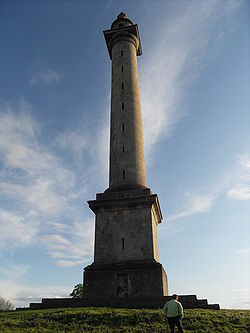Burton Pynsent Monument: Difference between revisions
Created page with "{{Infobox building |name=Burton Pynsent Monument |county=Somerset |picture=Burton Pynsent Monument.jpg |picture caption=The Burton Pynsent Monument |os grid ref=ST37672516 |la..." |
No edit summary |
||
| Line 16: | Line 16: | ||
The monument is a Grade I listed building.<ref>{{IoE|431251|Burton Pynsent Monument}}</ref> | The monument is a Grade I listed building.<ref>{{IoE|431251|Burton Pynsent Monument}}</ref> | ||
Alternative names for the tower, which stands on Troy Hill, a spur of high ground about | Alternative names for the tower, which stands on Troy Hill, a spur of high ground about half a mile north-east of [[Burton Pynsent House]], include the ''Curry Rivel Column'', ''Pynsent Column'', ''Pynsent Steeple'' or ''Cider Monument''.<ref name=holt>{{cite book|last=Holt|first=Jonathan|title=Somerset Follies|publisher=Akeman Press|pages=76–77|isbn=978-0-9546138-7-7}}</ref> | ||
The monument, which is clad in Portland Stone, was designed by Capability Brown and built by Philip Pear,<ref>{{cite web | url=http://www.britainexpress.com/counties/somerset/properties/Burton-Pynsent.htm | title=Burton Pynsent Monument | publisher=Britain Express | accessdate=22 November 2010}}</ref> at a cost of £2,000,<ref>{{cite web | url=http://www.somersetheritage.org.uk/record/55167 | title=Burton Pynsent | work=Somerset Historic Environment Record | publisher=Somerset County Council | accessdate=22 November 2010}}</ref> for William Pitt the Elder as a monument to Sir William Pynsent,<ref>{{cite web|url=http://www.follytowers.com/curryrival.html |title=Curry Rivel Column (Burton Pynsent) |publisher=Folly Towers |accessdate=2008-07-05 |archiveurl=https://web.archive.org/web/20080222065624/http://www.follytowers.com/curryrival.html |archivedate=2008-02-22 |deadurl=yes |df=}}</ref> of the Pynsent Baronets. | The monument, which is clad in Portland Stone, was designed by Capability Brown and built by Philip Pear,<ref>{{cite web | url=http://www.britainexpress.com/counties/somerset/properties/Burton-Pynsent.htm | title=Burton Pynsent Monument | publisher=Britain Express | accessdate=22 November 2010}}</ref> at a cost of £2,000,<ref>{{cite web | url=http://www.somersetheritage.org.uk/record/55167 | title=Burton Pynsent | work=Somerset Historic Environment Record | publisher=Somerset County Council | accessdate=22 November 2010}}</ref> for William Pitt the Elder as a monument to Sir William Pynsent,<ref>{{cite web|url=http://www.follytowers.com/curryrival.html |title=Curry Rivel Column (Burton Pynsent) |publisher=Folly Towers |accessdate=2008-07-05 |archiveurl=https://web.archive.org/web/20080222065624/http://www.follytowers.com/curryrival.html |archivedate=2008-02-22 |deadurl=yes |df=}}</ref> of the Pynsent Baronets. | ||
Revision as of 10:04, 11 February 2018
| Burton Pynsent Monument | |
|
Somerset | |
|---|---|
 The Burton Pynsent Monument | |
| Location | |
| Grid reference: | ST37672516 |
| Location: | 51°1’21"N, 2°53’24"W |
| History | |
| Built 1767 | |
| For: | William Pitt the Elder |
| Information | |
The Burton Pynsent Monument stands 140 feet high on Troy Hill at Burton Pynsent, within the parish of Curry Rivel in Somerset. It was built in 1767.
The monument is a Grade I listed building.[1]
Alternative names for the tower, which stands on Troy Hill, a spur of high ground about half a mile north-east of Burton Pynsent House, include the Curry Rivel Column, Pynsent Column, Pynsent Steeple or Cider Monument.[2]
The monument, which is clad in Portland Stone, was designed by Capability Brown and built by Philip Pear,[3] at a cost of £2,000,[4] for William Pitt the Elder as a monument to Sir William Pynsent,[5] of the Pynsent Baronets.
Pynsent was grateful to Pitt for opposing a ten shilling tax on a hogshead of cider (in the 1763 Cider Bill), which would have affected his business, so on his death he left his entire estate to Pitt.[6][7] Pitt then used some of the income from the estate (£3,000 a year) to erect the monument to his benefactor.
In June 1948 it was reported that a heifer climbed the 172 steps to the top of the monument, but was later returned safely to her hillside pasture.[8]
The tower was restored in the 1990s by the John Paul Getty Trust and English Heritage.[2]
| ("Wikimedia Commons" has material about Burton Pynsent Monument) |
References
- ↑ Images of England — details from listed building database (431251) Burton Pynsent Monument
- ↑ 2.0 2.1 Holt, Jonathan. Somerset Follies. Akeman Press. pp. 76–77. ISBN 978-0-9546138-7-7.
- ↑ "Burton Pynsent Monument". Britain Express. http://www.britainexpress.com/counties/somerset/properties/Burton-Pynsent.htm. Retrieved 22 November 2010.
- ↑ "Burton Pynsent". Somerset Historic Environment Record. Somerset County Council. http://www.somersetheritage.org.uk/record/55167. Retrieved 22 November 2010.
- ↑ "Curry Rivel Column (Burton Pynsent)". Folly Towers. Archived from the original on 2008-02-22. https://web.archive.org/web/20080222065624/http://www.follytowers.com/curryrival.html. Retrieved 2008-07-05.
- ↑ Byford, Enid (1987). Somerset Curiosities. Dovecote Press. p. 34. ISBN 0946159483.
- ↑ A History of the Right Honorable William Pitt, Earl of Chatham, p. 50, at Google Books
- ↑ Milwaukee Journal 15 June 1948
